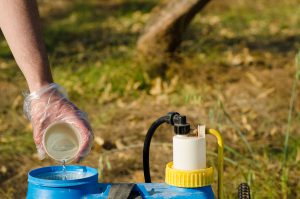The Dangers Of Pesticides
 Michael Babboni
Personal Injury
In early 2015, the World Health Organization issued a report which claimed that Monsanto’s flagship herbicide, Roundup, may cause lymphoma and other cancers in humans. In response, two US agricultural workers have launched personal injury lawsuits against the company, claiming that Roundup’s active ingredient, glyphosate, was responsible for causing their cancers.
Michael Babboni
Personal Injury
In early 2015, the World Health Organization issued a report which claimed that Monsanto’s flagship herbicide, Roundup, may cause lymphoma and other cancers in humans. In response, two US agricultural workers have launched personal injury lawsuits against the company, claiming that Roundup’s active ingredient, glyphosate, was responsible for causing their cancers.Killer Chemicals Are Dangerous (Go Figure)
Any kind of chemical can be dangerous if it’s mishandled. For some chemicals it’s harder than others, but it’s possible to overdose on something like vitamin C if you really work at it. You can even die from water poisoning.
However, pesticides are among the most dangerous chemicals which you can encounter in daily life, and the reason why is fairly obvious. Whether it’s an insecticide, an herbicide, a fungicide, or some other kind of killer, the point of a pesticide is to end the life of a certain species or group of species while keeping the things we like alive. However, engineering a perfectly selective chemical is easier said than done.
The classic example of unexpected consequences is DDT, which was first used to control insect populations during World War II. After the war, farmers used DDT constantly to protect their crops from insects, and while it was very successful, it also turned out that the chemical lingered in the environment.
DDT would drain from the fields and enter the water supply, where it would contaminate the algae and the seaweed. Fish would eat the algae, birds would eat the fish, and eventually the DDT prevented birds from creating eggs with thick shells. As a result, DDT nearly wiped out America’s bald eagle population, and the reason bald eagles are no longer endangered is because we banned the chemical in 1972.
The Modern Pesticide
It’s because of cases like DDT that farmers and others in need of pest control look to alternative solutions like introducing insect predators and other environmentally sound methods. At the same time, federal agencies are very careful about which chemicals they allow for use in American fields because of this potential for unintended side effects. A chemical has to kill only what it’s supposed to kill, and if it’s hazardous to humans it needs to be properly labeled as such so that the people who have to use it can take the proper safety precautions. This could mean gloves, a mask, or even a full hazard suit.
Roundup is, or at least was, a posterchild for a successfully selective product. Roundup kills a wide variety of harmful and unwanted plant life, and if that weren’t enough Monsanto has also created special “Roundup-ready” crop breeds which are resistant to glyphosate. At the same time, studies performed in the 1990s showed that glyphosate had little to no effect on humans. In other words, Roundup is the perfect herbicide for nearly every crop.
However, this new WHO study could change all that. The study’s results aren’t definitive and they aren’t backed up by similar studies with similar results, but if it turns out that glyphosate really is carcinogenic, and particularly if it turns out Monsanto knew this and intentionally falsified the earlier studies, then the company could be held liable for any number of individuals who got cancer because of exposure to Roundup. It still won’t be the most dangerous pesticide out there, but because these pesticides are properly labeled, the people who use them know how to protect themselves.
Based on the current body of evidence, it’s unlikely that a judge or jury will rule in favor of the two plaintiffs fighting against Monsanto and its host of defense lawyers. However, these cases will likely inspire more studies into the true effects of glyphosate, and so because of these lawsuits, the truth will eventually win out.
